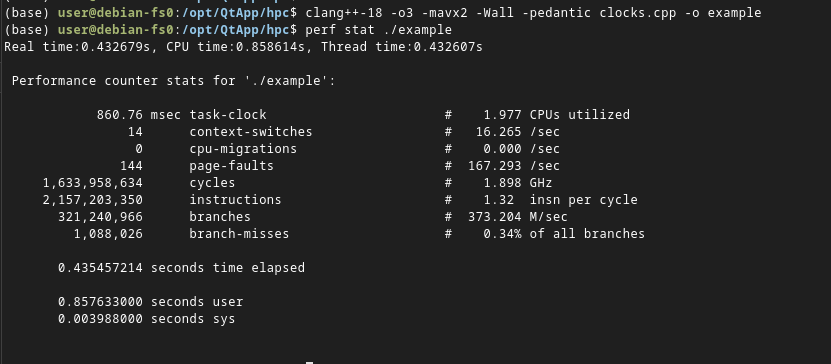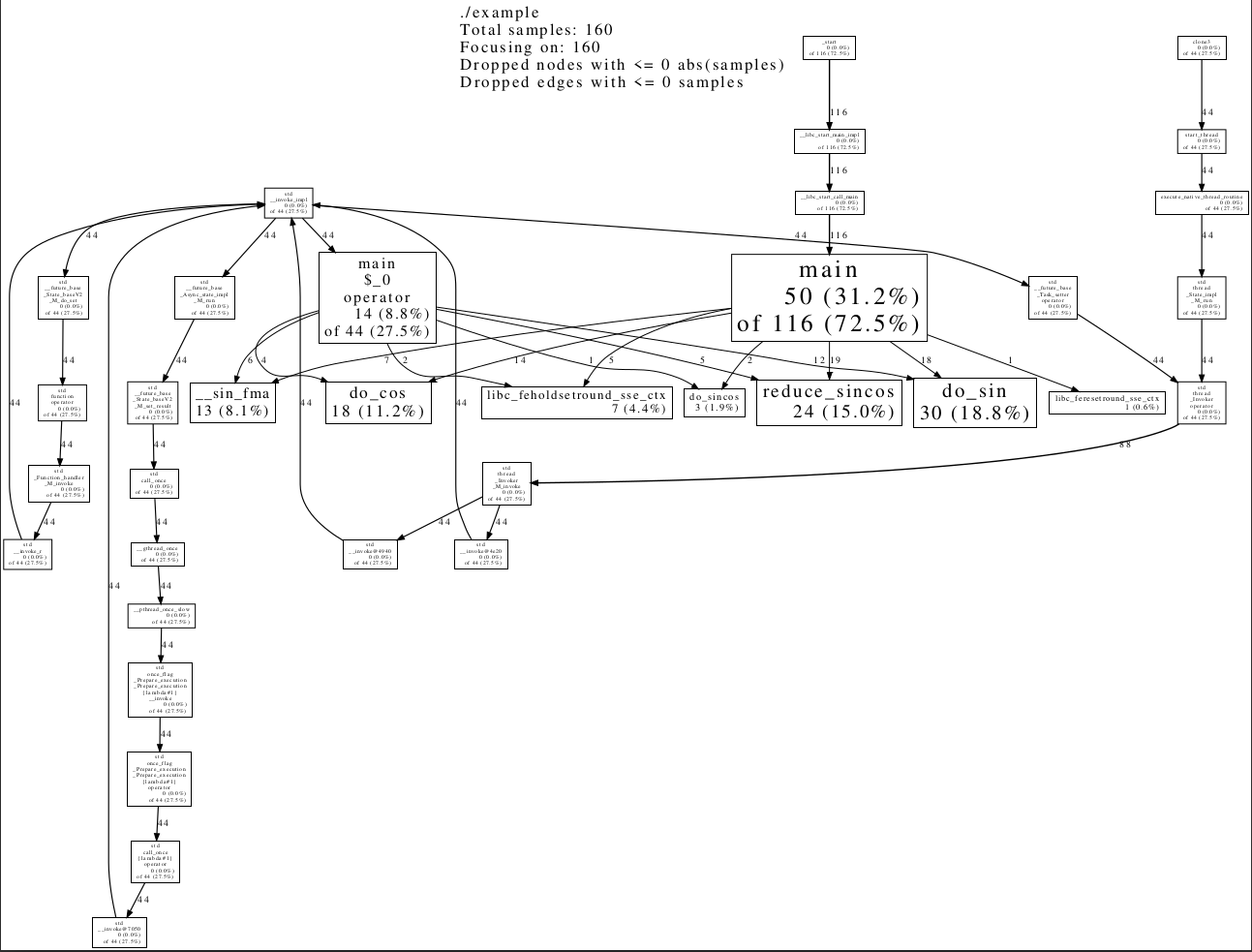高性能計算基礎(chǔ)
高性能計算基礎(chǔ)
測試環(huán)境:Debian 12
編譯器:gcc-15.1 clang++-18
1 性能評估指標(biāo)和測試工具
1.1 關(guān)注性能的原因
2005年前后,單個CPU的計算能力達(dá)到飽和。與之相關(guān)的因素在于:
CPU核心頻率停止增長。CPU核心頻率受制于多種因素,重要因素之一就是功耗。如果CPU頻率按照2005年前提升趨勢保持不變,那么今天的CPU每平方毫米的功耗可能比將火箭送入太空的大型噴氣發(fā)動機(jī)還要高。
然而,封裝在單個芯片中晶體管數(shù)量一致在增長。在芯片無法提升到更高的頻率情況下:
- 設(shè)計人員必須將多個處理器內(nèi)核放在同一個芯片上,而不是讓處理器變得更大。這些內(nèi)核的計算能力會隨著內(nèi)核數(shù)量的增加而增加,前提是程序員知道如何恰當(dāng)?shù)厥褂盟鼈儭?/li>
- 更多的晶體管對處理器進(jìn)行了各種非常先進(jìn)的增強(qiáng),這些增強(qiáng)可用于提高性能,同樣要求程序員知道如何正確使用它們。
1.2 程序的性能
效率(Efficiency)和性能(performance)的區(qū)別:
- 高效的程序不會讓可用的資源閑置。
- 高效的程序不會浪費(fèi)資源左不必要的工作。
- 性能總是與一些指標(biāo)有關(guān)。最常見的就是速度。
- 效率反映了計算資源的利用率,是實現(xiàn)良好性能的方式之一。
性能指標(biāo):
- 吞吐量(throughput)指標(biāo)
- 功耗指標(biāo)
- 實時應(yīng)用性能(尾部延時 tail latency)
- 上下文環(huán)境
如何編寫高性能應(yīng)用程序:
- 選擇正確的算法
- 有效利用CPU資源
- 有效使用內(nèi)存
- 避免不必要的計算
- 有效地使用并發(fā)和多線程
- 有效地使用編程語言,避免低效率
- 衡量性能和解釋結(jié)果
總體上可總結(jié)為:有效地使用硬件;有效地使用編程語言;有效地使用編譯器來生成最高效代碼;獲取良好的量化性能數(shù)據(jù)。
1.3 性能基準(zhǔn)測試
1.3.1 C++計時器
- std::chrono::system_clock
1.3.2 高分辨率計時器
- clock_gettime:要測量CPU時間,必須使用特定于操作系統(tǒng)的系統(tǒng)調(diào)用。在Linux和其他POSIX兼容系統(tǒng)上,開源使用clock_gettime()調(diào)用來訪問硬件高分辨率計時器。
- 實時時鐘:CLOCK_REALTIME
- 測量當(dāng)前程序使用的CPU時間:CLOCK_PROCESS_CPUTIME_ID
- 測量調(diào)用線程使用的時間:CLOCK_THREAD_CPUTIME_ID
測試代碼:
#include <chrono> #include <future> #include <iostream> #include <memory> #include <random> #include <vector> using std::chrono::duration_cast; using std::chrono::milliseconds; using std::chrono::system_clock; using std::cout; using std::endl; using std::minstd_rand; using std::unique_ptr; using std::vector; double duration(timespec a,timespec b) { return a.tv_sec-b.tv_sec+1e-9*(a.tv_nsec-b.tv_nsec); } int main() { timespec rt0,ct0,tt0; clock_gettime(CLOCK_REALTIME,&rt0); clock_gettime(CLOCK_PROCESS_CPUTIME_ID,&ct0); clock_gettime(CLOCK_THREAD_CPUTIME_ID,&tt0); constexpr double X =1e6; double s = 0; double s1 =0; //std::this_thread::sleep_for(std::chrono::seconds(1)); auto f = std::async(std::launch::async,[&]{ for(double x = 0; x<X; x+=0.1) { s+=sin(x); } }); for(double x =0;x<X;x+=0.1) s1 += sin(x); f.wait(); timespec rt1,ct1,tt1; clock_gettime(CLOCK_REALTIME,&rt1); clock_gettime(CLOCK_PROCESS_CPUTIME_ID,&ct1); clock_gettime(CLOCK_THREAD_CPUTIME_ID,&tt1); cout<<"Real time:"<<duration(rt1,rt0)<<"s, CPU time:"<<duration(ct1,ct0)<<"s, Thread time:"<<duration(tt1,tt0)<<"s"<<endl; return 0; }
1.4 性能分析
1.4.1 perf性能分析器
此性能分析器使用硬件性能計數(shù)器和基于時間采樣,因此不需要對代碼進(jìn)行任何檢測。運(yùn)行該性能分析器最簡單的方法是手機(jī)整個程序的計數(shù)器值。下圖是用perf stat命令完成的。

本示例中,程序運(yùn)行860ms,并執(zhí)行了超過21億條指令(instruction)。還顯示了page-faults(頁面錯誤)和branches(分支)
也可以執(zhí)行:
perf stat -e cycles,instructions,branches,branch-misses,cache-references,cache-misses ./example
輸出:
Real time:0.522098s, CPU time:0.933204s, Thread time:0.411307s Performance counter stats for './example': 1,646,305,868 cycles 2,155,999,666 instructions # 1.31 insn per cycle 320,999,448 branches 1,070,837 branch-misses # 0.33% of all branches 66,777,267 cache-references 79,258 cache-misses # 0.119 % of all cache refs 0.524856154 seconds time elapsed 0.936146000 seconds user 0.000000000 seconds sys
- cycles:周期時間,為CPU頻率的倒數(shù)。為了進(jìn)行準(zhǔn)確的性能分析和基礎(chǔ)測試,建議禁用省電模式和其他可能導(dǎo)致CPU時間變化的功能。
- instruction:指令計數(shù)器,測量已執(zhí)行的處理器指令數(shù)。該CPU每個周期平均執(zhí)行1.31條指令。
- branches:分支,即條件指令,每個if語句和每個帶條件的for循環(huán)都將至少生成這些指令之一。
- branch-misses:分支未命中,目前,從性能的角度來看,這是一個成本很高且不受歡迎的事件。
- cache-references:緩存引用,統(tǒng)計的是CPU從內(nèi)存中獲取某些數(shù)據(jù)所需的次數(shù)。
- cache-misses:根據(jù)處理器和內(nèi)存的狀態(tài),這種獲取可能非常快,也非常慢。對于非常慢的,計入cache-misses(緩存未命中)。緩存未命中也是一個成本很高的事件。
編譯代碼后:
clang++-18 -g -o3 -mavx2 -Wall -pedantic clocks.cpp -o example
可以使用perf record錄制性能分析樣本:
perf record ./example
然后使用perf report 分析樣本
perf report
1.4.2 Google Performance性能分析器
安裝:
sudo apt-get install google-perftools libgoogle-perftools-dev
Google CPU性能分析器可以使用硬件性能計數(shù)器,還需要代碼的鏈接時檢測。要準(zhǔn)備用于性能分析的代碼,必須將其與性能分析器庫鏈接(-lprofiler)。編譯指令如下:
clang++-18 -g -o3 -mavx2 -Wall -pedantic ./clocks.cpp -lprofiler -o example
獲取分析數(shù)據(jù):
CPUPROFILE=prof.data CPUPROFILE_FREQUENCY=1000 ./example
采樣交互模式使用性能分析器:
google-pprof ./example prof.data
輸出:
sing local file ./example. Using local file prof.data. Welcome to pprof! For help, type 'help'. (pprof) text Total: 160 samples 50 31.2% 31.2% 116 72.5% main 30 18.8% 50.0% 30 18.8% do_sin 24 15.0% 65.0% 24 15.0% reduce_sincos 18 11.2% 76.2% 18 11.2% do_cos 14 8.8% 85.0% 44 27.5% main::$_0::operator 13 8.1% 93.1% 13 8.1% __sin_fma 7 4.4% 97.5% 7 4.4% libc_feholdsetround_sse_ctx 3 1.9% 99.4% 3 1.9% do_sincos 1 0.6% 100.0% 1 0.6% libc_feresetround_sse_ctx 0 0.0% 100.0% 44 27.5% __gthread_once (pprof)
查看用執(zhí)行時間百分比注釋的所有函數(shù)的摘要信息:
(pprof) text --lines Total: 160 samples 33 20.6% 20.6% 99 61.9% main /opt/QtApp/hpc/./clocks.cpp:41 17 10.6% 31.2% 17 10.6% main /opt/QtApp/hpc/./clocks.cpp:40 9 5.6% 36.9% 39 24.4% main::$_0::operator /opt/QtApp/hpc/./clocks.cpp:36 8 5.0% 41.9% 8 5.0% do_sin ./math/../sysdeps/ieee754/dbl-64/s_sin.c:144 7 4.4% 46.2% 7 4.4% libc_feholdsetround_sse_ctx ./math/../sysdeps/x86/fpu/fenv_private.h:416 7 4.4% 50.6% 7 4.4% reduce_sincos ./math/../sysdeps/ieee754/dbl-64/s_sin.c:165 6 3.8% 54.4% 6 3.8% do_sin ./math/../sysdeps/ieee754/dbl-64/s_sin.c:129 5 3.1% 57.5% 5 3.1% __sin_fma ./math/../sysdeps/x86_64/fpu/multiarch/s_sin-fma.c:201 5 3.1% 60.6% 5 3.1% do_cos ./math/../sysdeps/ieee754/dbl-64/s_sin.c:114 5 3.1% 63.8% 5 3.1% main::$_0::operator /opt/QtApp/hpc/./clocks.cpp:34 (pprof)
性能分析器通常使用調(diào)用圖(call graph)來呈現(xiàn)此信息:調(diào)用方(caller)和被調(diào)用方(callee)是圖中的節(jié)點。在這個圖中我們可以了解在每個函數(shù)和代碼行上執(zhí)行了多少時間,還可以知道每個調(diào)用鏈花了多少時間。
google-pprof --pdf ./example prof.data >prof.pdf

1.4.3 收集性能數(shù)據(jù)的方法(微基準(zhǔn)測試)
- 微基準(zhǔn)測試的基礎(chǔ)知識:微基準(zhǔn)測試 (micro-benchmark)一種對函數(shù)進(jìn)行調(diào)用并測量結(jié)果,也就是運(yùn)行一小段代碼并測量其性能。
- 微基準(zhǔn)測試工具:Google Benchmark。
Google Benchmark安裝:
sudo apt install libbenchmark-dev
Google Benchmark用法:
#include <benchmark/benchmark.h> #include <string> #include <sstream> #include <vector> #include <cmath> // 示例1:測試不同的字符串拼接方法 static void BM_StringPlusOperator(benchmark::State& state) { for (auto _ : state) { std::string result; for (int i = 0; i < state.range(0); ++i) { result += "hello"; } benchmark::DoNotOptimize(result); } } // 正確的參數(shù)設(shè)置方式 BENCHMARK(BM_StringPlusOperator)->RangeMultiplier(2)->Range(1, 1024); static void BM_StringAppend(benchmark::State& state) { for (auto _ : state) { std::string result; for (int i = 0; i < state.range(0); ++i) { result.append("hello"); } benchmark::DoNotOptimize(result); } } BENCHMARK(BM_StringAppend)->RangeMultiplier(2)->Range(1, 1024); static void BM_StringStream(benchmark::State& state) { for (auto _ : state) { std::stringstream ss; for (int i = 0; i < state.range(0); ++i) { ss << "hello"; } std::string result = ss.str(); benchmark::DoNotOptimize(result); } } BENCHMARK(BM_StringStream)->RangeMultiplier(2)->Range(1, 1024); // 示例2:測試向量操作性能 static void BM_VectorPushBack(benchmark::State& state) { for (auto _ : state) { std::vector<int> vec; vec.reserve(state.range(0)); for (int i = 0; i < state.range(0); ++i) { vec.push_back(i); } benchmark::DoNotOptimize(vec); } } BENCHMARK(BM_VectorPushBack)->RangeMultiplier(2)->Range(8, 1024); static void BM_VectorEmplaceBack(benchmark::State& state) { for (auto _ : state) { std::vector<int> vec; vec.reserve(state.range(0)); for (int i = 0; i < state.range(0); ++i) { vec.emplace_back(i); } benchmark::DoNotOptimize(vec); } } BENCHMARK(BM_VectorEmplaceBack)->RangeMultiplier(2)->Range(8, 1024); // 示例3:帶有復(fù)雜計算的測試 static void BM_ComplexCalculation(benchmark::State& state) { const int size = state.range(0); std::vector<double> data(size); for (int i = 0; i < size; ++i) { data[i] = i * 0.1; } for (auto _ : state) { double sum = 0.0; for (int i = 0; i < size; ++i) { sum += std::sin(data[i]) * std::cos(data[i]); } benchmark::DoNotOptimize(sum); } } BENCHMARK(BM_ComplexCalculation)->RangeMultiplier(4)->Range(64, 4096); // 示例4:使用自定義計數(shù)器 static void BM_MatrixMultiplication(benchmark::State& state) { const int n = state.range(0); for (auto _ : state) { // 簡化版的矩陣乘法,避免大量內(nèi)存分配影響測試結(jié)果 double sum = 0.0; for (int i = 0; i < n; ++i) { for (int j = 0; j < n; ++j) { for (int k = 0; k < n; ++k) { sum += i * k + j * k; // 模擬計算 } } } benchmark::DoNotOptimize(sum); // 正確的計數(shù)器設(shè)置方式 state.counters["FLOPs"] = benchmark::Counter( static_cast<double>(2 * n * n * n), benchmark::Counter::kIsRate ); state.counters["MatrixSize"] = n; } } // 使用ArgsProduct測試多個參數(shù)組合 BENCHMARK(BM_MatrixMultiplication)->Args({10})->Args({20})->Args({30}); // 示例5:簡單的循環(huán)測試(無參數(shù)) static void BM_EmptyLoop(benchmark::State& state) { for (auto _ : state) { // 空循環(huán),測試基準(zhǔn)開銷 } } BENCHMARK(BM_EmptyLoop); // 示例6:內(nèi)存訪問模式測試 static void BM_MemoryAccess(benchmark::State& state) { const int size = state.range(0); std::vector<int> data(size, 1); for (auto _ : state) { int sum = 0; // 順序訪問 for (int i = 0; i < size; ++i) { sum += data[i]; } benchmark::DoNotOptimize(sum); } } BENCHMARK(BM_MemoryAccess)->Arg(1000)->Arg(10000)->Arg(100000); // 示例7:使用模板的基準(zhǔn)測試 template<typename T> static void BM_TemplateTest(benchmark::State& state) { for (auto _ : state) { T result = T(); for (int i = 0; i < state.range(0); ++i) { result += static_cast<T>(i); } benchmark::DoNotOptimize(result); } } // 注冊模板測試 BENCHMARK_TEMPLATE(BM_TemplateTest, int)->Range(1, 1000); BENCHMARK_TEMPLATE(BM_TemplateTest, double)->Range(1, 1000); BENCHMARK_TEMPLATE(BM_TemplateTest, float)->Range(1, 1000); BENCHMARK_MAIN();
編譯:
clang++-18 -O3 -I/usr/local/include -L/usr/local/lib ./test_benchmark.cpp -lbenchmark -lpthread -o benchmark_example
如果能看到輸出的性能測試結(jié)果,就說明 Google Benchmark 庫已經(jīng)成功安裝并可以正常工作了:
./benchmark_example 2025-09-23T23:12:40-10:00 Running ./benchmark_example Run on (4 X 3900 MHz CPU s) CPU Caches: L1 Data 32 KiB (x4) L1 Instruction 32 KiB (x4) L2 Unified 256 KiB (x4) L3 Unified 6144 KiB (x1) Load Average: 0.12, 0.44, 0.45 ***WARNING*** CPU scaling is enabled, the benchmark real time measurements may be noisy and will incur extra overhead. ***WARNING*** Library was built as DEBUG. Timings may be affected. ----------------------------------------------------------------------- Benchmark Time CPU Iterations ----------------------------------------------------------------------- BM_StringPlusOperator/1 14.8 ns 14.8 ns 41141692 BM_StringPlusOperator/2 23.5 ns 23.5 ns 27457916 BM_StringPlusOperator/4 75.6 ns 75.6 ns 8516886 BM_StringPlusOperator/8 133 ns 133 ns 4835163 BM_StringPlusOperator/16 228 ns 228 ns 2924758 BM_StringPlusOperator/32 368 ns 368 ns 1816380 BM_StringPlusOperator/64 700 ns 700 ns 905954 BM_StringPlusOperator/128 1245 ns 1245 ns 525369 BM_StringPlusOperator/256 2319 ns 2318 ns 291399 BM_StringPlusOperator/512 4341 ns 4341 ns 159391 BM_StringPlusOperator/1024 8428 ns 8428 ns 77097 BM_StringAppend/1 10.8 ns 10.8 ns 62091856 BM_StringAppend/2 18.6 ns 18.6 ns 36557304 BM_StringAppend/4 67.9 ns 67.9 ns 9695255 BM_StringAppend/8 126 ns 126 ns 5336449 BM_StringAppend/16 214 ns 214 ns 3143867 BM_StringAppend/32 379 ns 379 ns 1824693 BM_StringAppend/64 681 ns 681 ns 935922 BM_StringAppend/128 1202 ns 1202 ns 549609
1.4.4 案例解析
- 測試代碼
#include <benchmark/benchmark.h> #include <memory> #include <cstring> bool compare_int(const char* s1,const char* s2) { char c1,c2; for(int i1=0,i2=0;;++i1,++i2) { c1=s1[i1];c2=s2[i2]; if(c1!=c2) return c1>c2; } } void BM_loop_int(benchmark::State& state) { const unsigned int N = state.range(0); std::unique_ptr<char[]>s(new char[2*N]); ::memset(s.get(),'a',2*N*sizeof(char)); s[2*N-1] =0; const char* s1 = s.get(),*s2=s1+N; for(auto _:state){ benchmark::DoNotOptimize(compare_int(s1,s2)); } state.SetItemsProcessed(N*state.iterations()); } BENCHMARK(BM_loop_int)->Arg(1<<20); BENCHMARK_MAIN();
- 編譯指令:
clang++-18 -g -O3 -mavx2 -Wall -pedantic -I/usr/local/include -L/usr/local/lib ./10_compare_mbm.cpp -lbenchmark -lpthread -lrt -lm -o 10_compare_mbm
- 輸出:
./10_compare_mbm 2025-09-23T23:31:56-10:00 Running ./10_compare_mbm Run on (4 X 3900 MHz CPU s) CPU Caches: L1 Data 32 KiB (x4) L1 Instruction 32 KiB (x4) L2 Unified 256 KiB (x4) L3 Unified 6144 KiB (x1) Load Average: 0.06, 0.68, 0.72 ***WARNING*** CPU scaling is enabled, the benchmark real time measurements may be noisy and will incur extra overhead. ***WARNING*** Library was built as DEBUG. Timings may be affected. ------------------------------------------------------------------------------ Benchmark Time CPU Iterations UserCounters... ------------------------------------------------------------------------------ BM_loop_int/1048576 641864 ns 641837 ns 1055 items_per_second=1.63371G/s
- 解析:
每個Google Benchmark基準(zhǔn)測試程序都必須包含該庫頭文件<benchmark/benchmark.h>。BM_loop_int首先設(shè)置運(yùn)行代碼的輸入數(shù)據(jù),本示例中,代碼的輸入是字符串,所以需要分配和初始化字符串。函數(shù)退出時要清理初始化數(shù)據(jù),本例中使用std::unique_ptr對象的析構(gòu)函數(shù)執(zhí)行。
BENCHMARK指定要傳遞給基準(zhǔn)測試fixture的任何參數(shù)的地方。影響基準(zhǔn)測試的參數(shù)和其他選項將使用重載的箭頭運(yùn)算符傳遞。
代碼清單中沒有main函數(shù),而是使用宏BENCHMARK_MAIN()。用來完成設(shè)置基準(zhǔn)測試環(huán)境、注冊基準(zhǔn)測試和執(zhí)行它們所有必要的工作。
benchmark::DoNotOptimize()包裝函數(shù)的作用類似使用volatile,用于確保編譯器不會優(yōu)化對compare_int()的整個調(diào)用。實際上并沒關(guān)閉任何優(yōu)化,特別是括號里面的代碼照常優(yōu)化。
編譯時需要指定Google Benchmark 頭文件和庫文件路,Google Benchmark庫libbenchmark庫以及若干額外的庫。
一旦被調(diào)用,基準(zhǔn)測試程序會打印關(guān)于正在運(yùn)行的系統(tǒng)的信息,然后執(zhí)行每個已注冊的fixture。
每個基準(zhǔn)測試fixture和一組參數(shù)都將得到一行輸出。該報告包括基準(zhǔn)測試循環(huán)主體單次執(zhí)行的平均實時時間和平均CPU時間、循環(huán)執(zhí)行次數(shù)以及附加到報告中的讓其他統(tǒng)計信息(本例中時比較函數(shù)每秒處理的字符數(shù),每個超過1.6G個字符)。
這些數(shù)據(jù)在每次運(yùn)行中相差多少,如果使用正確的命令行參數(shù)啟用統(tǒng)計信息收集,則基準(zhǔn)測試庫可以為我們計算出結(jié)果。例如,每重復(fù)基準(zhǔn)測試10次并報告結(jié)果,則運(yùn)行的基準(zhǔn)測試將如下所示:
./10_compare_mbm --benchmark_repetitions=10 --benchmark_report_aggregates_only=true 2025-09-24T00:04:08-10:00 Running ./10_compare_mbm Run on (4 X 3900 MHz CPU s) CPU Caches: L1 Data 32 KiB (x4) L1 Instruction 32 KiB (x4) L2 Unified 256 KiB (x4) L3 Unified 6144 KiB (x1) Load Average: 0.06, 0.03, 0.09 ***WARNING*** CPU scaling is enabled, the benchmark real time measurements may be noisy and will incur extra overhead. ***WARNING*** Library was built as DEBUG. Timings may be affected. ------------------------------------------------------------------------------------- Benchmark Time CPU Iterations UserCounters... ------------------------------------------------------------------------------------- BM_loop_int/1048576_mean 485082 ns 485056 ns 10 items_per_second=2.18225G/s BM_loop_int/1048576_median 458741 ns 458722 ns 10 items_per_second=2.28596G/s BM_loop_int/1048576_stddev 52421 ns 52414 ns 10 items_per_second=211.207M/s BM_loop_int/1048576_cv 10.81 % 10.81 % 10 items_per_second=9.68%
如此,我們可以對子串比較函數(shù)的不同變體進(jìn)行基準(zhǔn)測試,并找出哪個變體最快。
2 CPU流水線、推測窒息和分支優(yōu)化
2.1 指令級并行(ILP, instruction-level parallelism)
只要操作數(shù)已經(jīng)在寄存器中,處理器就可以一次執(zhí)行若干個操作。當(dāng)然,可以執(zhí)行的操作數(shù)量是有限的,因為處理器能夠進(jìn)行整數(shù)計算的執(zhí)行單元有限。盡管如此,通過在一次迭代中添加越來越多的指令來嘗試將CPU推向極限是有益的。
如下兩個迭代執(zhí)行時間是差不多的:
//迭代一 for(size_t i =0;i<N;++i) { a1 +=p1[i]+p2[i]; } //迭代二 for(size_t i =0;i<N;++i) { a1 +=p1[i]+p2[i]; a2 +=p1[i]*p2[i]; a3 +=p1[i]<<2; a4 +=p2[i]-p1[i]; a5 +=(p2[i]<<2)*p2[i]; a6 +=(p2[i]-3)*p1[i]; }
測試代碼如下:
#include <benchmark/benchmark.h> #include <vector> void BM_add(benchmark::State& state) { srand(1); const unsigned int N = state.range(0); std::vector<unsigned long> v1(N),v2(N); for(size_t i=0;i<N;++i) { v1[i]=rand(); v2[i]=rand(); } unsigned long* p1= v1.data(); unsigned long* p2 = v2.data(); for([[maybe_unused]]auto _:state) { unsigned long a1 =0; for(size_t i =0;i<N;++i) { a1 +=p1[i]+p2[i]; } benchmark::DoNotOptimize(a1); benchmark::ClobberMemory(); } state.SetItemsProcessed(N*state.iterations()); } void BM_ILP(benchmark::State& state) { srand(1); const unsigned int N = state.range(0); std::vector<unsigned long> v1(N),v2(N); for(size_t i=0;i<N;++i) { v1[i]=rand(); v2[i]=rand(); } unsigned long* p1= v1.data(); unsigned long* p2 = v2.data(); for([[maybe_unused]]auto _:state) { unsigned long a1 =0,a2=0,a3=0,a4=0,a5=0,a6=0; for(size_t i =0;i<N;++i) { a1 +=p1[i]+p2[i]; a2 +=p1[i]*p2[i]; a3 +=p1[i]<<2; a4 +=p2[i]-p1[i]; a5 +=(p2[i]<<2)*p2[i]; a6 +=(p2[i]-3)*p1[i]; } benchmark::DoNotOptimize(a1); benchmark::DoNotOptimize(a2); benchmark::DoNotOptimize(a3); benchmark::DoNotOptimize(a4); benchmark::DoNotOptimize(a5); benchmark::DoNotOptimize(a6); benchmark::ClobberMemory(); } state.SetItemsProcessed(N*state.iterations()); } void BM_mutiply(benchmark::State& state) { srand(1); const unsigned int N = state.range(0); std::vector<unsigned long> v1(N),v2(N); for(size_t i=0;i<N;++i) { v1[i]=rand(); v2[i]=rand(); } unsigned long* p1= v1.data(); unsigned long* p2 = v2.data(); for([[maybe_unused]]auto _:state) { unsigned long a1 =0; for(size_t i =0;i<N;++i) { a1 +=p1[i]*p2[i]; } benchmark::DoNotOptimize(a1); benchmark::ClobberMemory(); } state.SetItemsProcessed(N*state.iterations()); } BENCHMARK(BM_add)->Arg(1<<22); BENCHMARK(BM_ILP)->Arg(1<<22); BENCHMARK(BM_mutiply)->Arg(1<<22); BENCHMARK_MAIN();
輸出:
./superscalar 2025-09-24T19:48:37-10:00 Running ./superscalar Run on (4 X 3900 MHz CPU s) CPU Caches: L1 Data 32 KiB (x4) L1 Instruction 32 KiB (x4) L2 Unified 256 KiB (x4) L3 Unified 6144 KiB (x1) Load Average: 0.01, 0.08, 0.18 ***WARNING*** CPU scaling is enabled, the benchmark real time measurements may be noisy and will incur extra overhead. ***WARNING*** Library was built as DEBUG. Timings may be affected. ----------------------------------------------------------------------------- Benchmark Time CPU Iterations UserCounters... ----------------------------------------------------------------------------- BM_add/4194304 5793066 ns 5792942 ns 100 items_per_second=724.037M/s BM_ILP/4194304 8123805 ns 8122965 ns 88 items_per_second=516.351M/s BM_mutiply/4194304 5256256 ns 5256241 ns 100 items_per_second=797.966M/s
3 現(xiàn)代內(nèi)存架構(gòu)、訪問模式以及對算法和數(shù)據(jù)結(jié)構(gòu)設(shè)計的影響
4 多線程和并發(fā)工作原理
5 鎖、無鎖和無等待及并發(fā)數(shù)據(jù)結(jié)構(gòu)的基礎(chǔ)知識
5.1 鎖
5.2 無鎖
5.3 無等待
5.4 并發(fā)數(shù)據(jù)結(jié)構(gòu)基礎(chǔ)知識
使用多線程的并發(fā)程序需要線程安全的數(shù)據(jù)結(jié)構(gòu)。線程安全的數(shù)據(jù)結(jié)構(gòu)是指:如果一個數(shù)據(jù)結(jié)構(gòu)可以被多個線程同時使用而且沒有任何數(shù)據(jù)競爭(線程之間共享),那么它就是線程安全的:
- 把標(biāo)準(zhǔn)抬的很高,例如:沒有一個STL容器被認(rèn)為是線程安全的。
- 帶來的性能成本非常高。
- 通常是不必要的,沒必要因此多花成本。
- 最重要的是,在許多情況下完全用不上
對象被一個線程單獨(dú)占用時不需要線程安全。
只要線程不修改對象,那么許多數(shù)據(jù)結(jié)構(gòu)在多線程代碼中使用是安全的。用例:std::shared_ptr,當(dāng)復(fù)制共享指針時,復(fù)制的對象不會被修改,它通過const應(yīng)用被傳遞給新指針的構(gòu)造函數(shù),同時對象中的引用計數(shù)必須遞增。意味著復(fù)制的來源發(fā)送了變化。在這種情況下共享指針是線程安全的,但也有性能成本。
線程安全的最高級別通常稱為強(qiáng)線程安全保證(strong thread safety guarantee):提供此保證的對象可以被多個線程并發(fā)使用而不會導(dǎo)致數(shù)據(jù)競爭或其他未定義行為。
下一個級別稱為弱線程安全保證(weak thread safety guarantee):意味著,首先,只要所有線程都被限制為只讀訪問(調(diào)用類的const成員函數(shù)),那么提供該保證的對象就可以同時被多個線程訪問。其次,人后線程只要可以獨(dú)占訪問一個對象,即可對其執(zhí)行任何有效操作,而不管其他線程同時在做什么。
- 線程安全(thread-safe):提供強(qiáng)線程安全保證的類稱為線程安全(thread-safe)。
- 線程兼容(thread compatible):僅提供弱線程保證的類被稱為線程兼容(thread compatible)。大多數(shù)STL容器提供這樣的保證:如果某個容器是一個線程本地容器,則可以安任何有效方式使用它;如果某個容器對象是共享的,則只能調(diào)用const成員函數(shù)。
- 線程對立(thread-hostile):根本不提供任何保證的類被稱為線程對立(thread-hostile)。
6 線程安全的數(shù)據(jù)結(jié)構(gòu)(并發(fā)數(shù)據(jù)結(jié)構(gòu))
6.1 最好的線性安全性
最好的解決方案是在每個線程上維護(hù)本地計數(shù)并且只增加共享計數(shù)一次。
對比如下偽代碼(注:第二種寫法由于第一種):
寫法一:
std::atomic<unsigned log> count; //在某個線程上 for(...counting loop...) { if(...found...) { count.fetch_add(1,std::memory_order_relaxed); } }
寫法二:
unsigned long count; std::mutex M; //在某個線程上 unsigned long local_count =0; for(...counting loop...) { if(...found...) { ++local_count; } } std::lock_guard<std::mutex> L(M); count +=local_count;
6.2 線程安全棧
C++標(biāo)準(zhǔn)庫提供了std::stack容器。所有的C++容器都提供弱線程安全保證:一個只讀容器可以被多個線程安全訪問。也就是只要沒有線程調(diào)用任何非const方法,任何數(shù)量的線程都可以同時調(diào)用任何const方法。
當(dāng)至少有一個線程正在修改占,而我們需要更強(qiáng)的保證。最直接的方法是利用互斥鎖保護(hù)類的每個成員函數(shù)。這可以在應(yīng)用程序級別完成,但這種實現(xiàn)不強(qiáng)制線程安全,容易出錯,也難于調(diào)試,因為鎖與容器無關(guān)聯(lián)。
所以,更好的選擇就是使用我們自己的棧類包裝。
#include <stack> #include <mutex> #include <optional> #include <benchmark/benchmark.h> template<typename T> class mt_stack{ private: std::stack<T> s_; std::mutex l_; public: mt_stack() = default; std::optional<T> pop() { std::lock_guard g(l_); if(s_.empty()) { return std::optional<T>(std::nullopt); }else{ std::optional<T> res(std::move(s_.top())); s_.pop(); return res; } } void push(const T& v) { std::lock_guard g(l_); s_.push(v); } };
7 C++標(biāo)準(zhǔn)中的并發(fā)編程特性
8 零拷貝
9 編譯器優(yōu)化基礎(chǔ)知識
10 高性能編程設(shè)計總結(jié)


 浙公網(wǎng)安備 33010602011771號
浙公網(wǎng)安備 33010602011771號